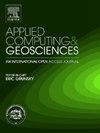评估人工智能驱动的火山岩测年数据可靠性:电子探针和激光烧蚀质谱的比较
IF 3.2
Q2 COMPUTER SCIENCE, INTERDISCIPLINARY APPLICATIONS
引用次数: 0
摘要
本研究探讨了人工智能(AI)与现代数据分析的结合,以准确预测和分类三个不同时期的火山活动。通过利用以前定年的火山样本,我们评估了现有的年龄和地球化学数据是否能够可靠地分组和预测火山事件。我们的研究重点是库拉火山省(土耳其)。我们比较了两种分析技术——电子显微探针分析(EPMA)和激光烧蚀电感耦合等离子体质谱(LA-ICP-MS)——在为训练深度学习模型生成高质量数据集方面的有效性。虽然EPMA提供了主要和次要元素组成,但LA-ICP-MS提供了更广泛的微量元素,这可能提高分类的准确性。通过两项实验对人工智能火山岩年龄估算的可行性进行了评价。在第一个实验中,采用自编码器和无监督聚类方法对样本进行降维,并根据元素组成对样本进行分组。结果表明,EPMA数据缺乏足够的细节来形成定义明确的簇,而LA-ICP-MS数据由于对微量元素的更高灵敏度而产生的簇与真实年龄类别密切相关。在第二个实验中,训练深度神经网络(DNN)对岩石年龄进行分类。基于la - icp - ms的模型实现了95%的分类准确率,显著优于基于epma的模型(72%)。这些发现强调了数据质量和分析技术选择在人工智能地质年代学中的重要性,表明高质量的微量元素数据提高了火山岩年龄估计的人工智能模型性能。本文章由计算机程序翻译,如有差异,请以英文原文为准。
Assessing data reliability for AI-driven volcanic rock dating: A comparison of electron microprobe and laser ablation mass spectroscopy
This study explores the integrationof artificial intelligence (AI) and modern data analytics for accurately predicting and classifying three distinct periods of volcanic activity. By leveraging previously dated volcanic samples, we assess whether existing age and geochemical data can reliably group and predict volcanic episodes. Our study focuses on the Kula Volcanic Province (Turkey). We compare the effectiveness of two analytical techniques—Electron Microprobe Analysis (EPMA) and Laser Ablation Inductively Coupled Plasma Mass Spectrometry (LA-ICP-MS)—in producing high-quality datasets for training deep learning models. While EPMA provides major and minor elemental compositions, LA-ICP-MS offers a broader range of trace elements, which may improve classification accuracy. Two experiments were conducted to evaluate the feasibility of AI-based volcanic rock age estimation. In the first experiment, an autoencoder and unsupervised clustering were applied to reduce dimensionality and group samples based on their elemental composition. The results revealed that EPMA data lacked sufficient detail to form well-defined clusters, whereas LA-ICP-MS data produced clusters that closely aligned with true age classes due to their higher sensitivity to trace elements. In the second experiment, a deep neural network (DNN) was trained to classify rock ages. The LA-ICP-MS-based model achieved a classification accuracy of 95 %, significantly outperforming the EPMA-based model (72 %). These findings underscore the importance of data quality and analytical technique selection in AI-powered geochronology, demonstrating that high-quality trace element data enhances AI model performance for volcanic rock age estimation.
求助全文
通过发布文献求助,成功后即可免费获取论文全文。
去求助
来源期刊

Applied Computing and Geosciences
Computer Science-General Computer Science
CiteScore
5.50
自引率
0.00%
发文量
23
审稿时长
5 weeks
 求助内容:
求助内容: 应助结果提醒方式:
应助结果提醒方式:


